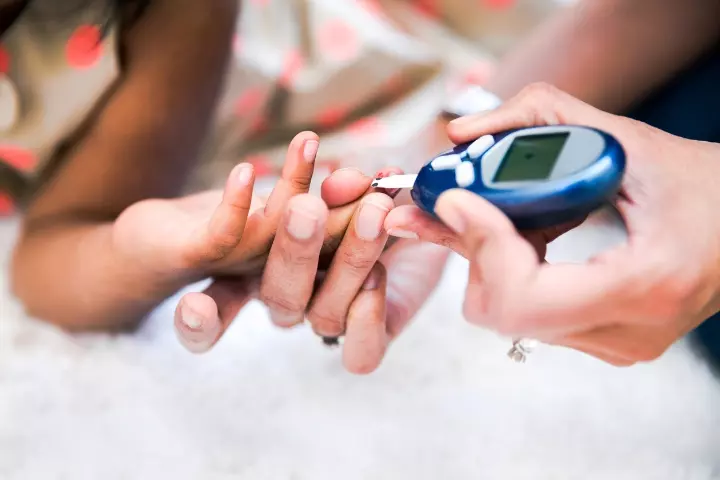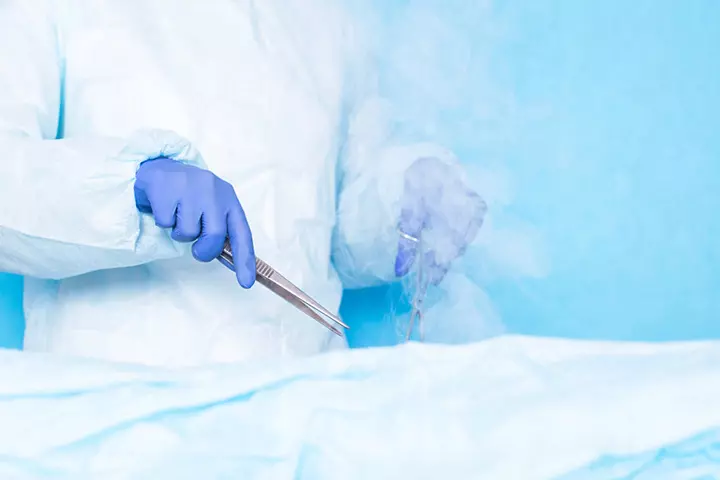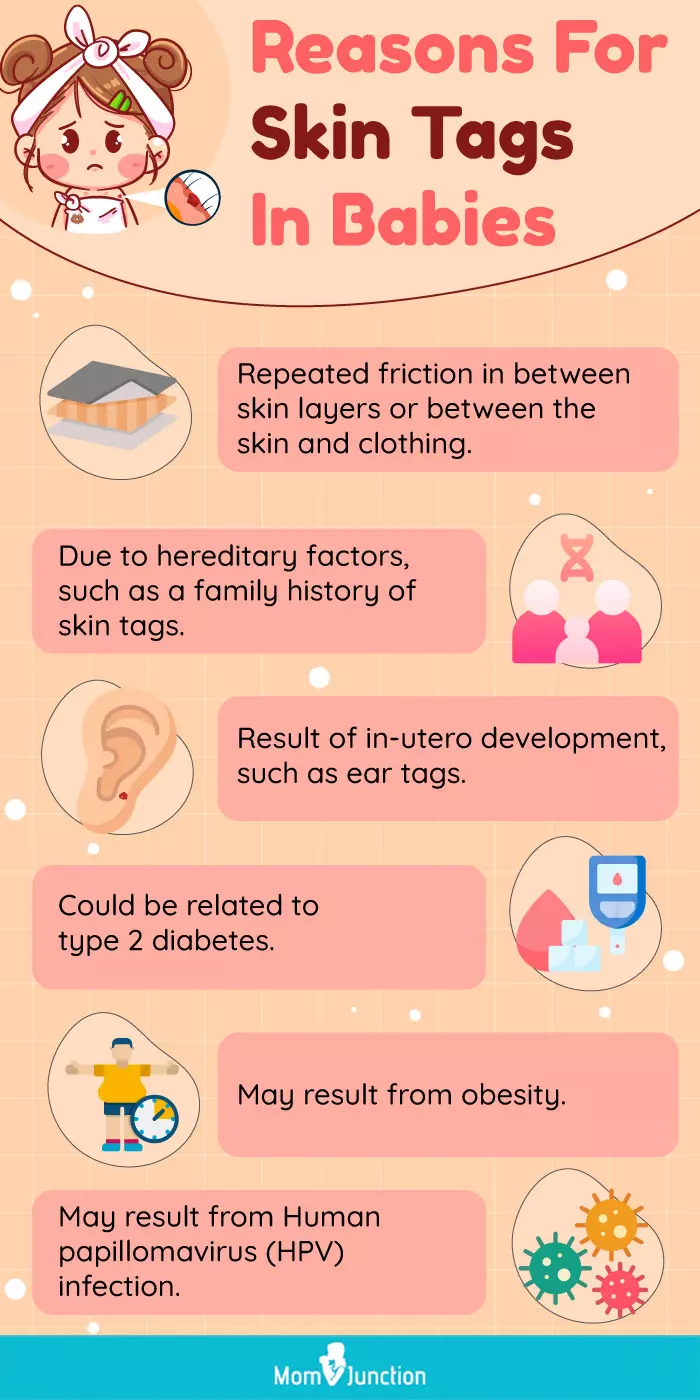
Image: ShutterStock
Skin tags in babies are characterized by small nodules of excess skin growth on the body. It is not unusual to see these extra skin growths on the baby’s body, but you need not panic. These may feel soft or fleshy when touched. The medical terminology for a skin tag includes fibroma pendulum, fibroepithelial polyp, or acrochordon (1). Read this post to understand the causes, harmful side effects, treatment options, and natural remedies for managing skin tags on a baby’s body.
Key Pointers
- Skin tags are small flaps of tissue that hang from the skin via a fleshy tissue called a “stalk” or a “peduncle”, usually found on several parts of the body and have the same color as the skin.
- They are usually painless and not associated with an underlying skin disease.
- Skin tags in babies are caused by in-utero development, repeated skin friction, hereditary reasons, obesity, etc.
- Skin tags are not contagious and are generally not harmful to babies, but consulting a pediatrician is recommended, whether the skin tag causes pain or not.
- Natural remedies such as tea tree oil and banana peel may help shrink skin tags. Skin tags do not require medical intervention, and removal is only recommended if they cause trouble for the baby.
What Is A Skin Tag?
A skin tag is a small flap of tissue that hangs from the skin via a fleshy tissue called a “stalk” or a “peduncle.”
Skin tags are usually skin-colored and found on several parts of the body. If a tag twists on its stalk, then it may develop a blood clot, which may cause the skin tag to appear red or black in color (1).
The size of a tag could range from 1mm to 1cm (18). A skin tag is usually painless and not associated with any underlying disease.
Do not get confused between skin tags and warts in babies or infantile hemangiomas. A skin tag looks like a balloon raised from the skin by a stalk, while a wart is flat and only slightly raised from the skin. Similarly, infantile hemangiomas are colored patches on the skin that shrink over time. It may also be mistaken for urticaria, which is an itchy rash on the skin. Skin tags, on the other hand, are not itchy unless irritated by friction.
Where Are Skin Tags Found On Babies?
Skin tags on babies could occur in these parts of the body (2).
- Eyelids
- Groin
- Neck
- Armpits
- Ears
Skin tags tend to grow in skin folds. Therefore, you may see them in various other places than those mentioned here.
A mother and a daily-vlogger, Madison Miller shares about her baby’s skin tags and other updates. She says, “My baby girl has a skin tag near her left ear. The doctor checked for her hearing and kidney. She was deemed totally fine after the tests were conducted. As I have understood, it is a cosmetic thing and we are going to get it removed in the coming months (i).”
How Are Skin Tags Diagnosed?
Skin tags are usually diagnosed by visual examination by a healthcare expert, such as a dermatologist or general practitioner. During this process, they may inquire about your baby’s medical history, focusing on factors that increase the likelihood of skin tags. Furthermore, a brief inspection is conducted to eliminate abnormal growths resembling skin tags (3).
What Causes Skin Tags In Babies?
The presence of skin tags on babies may not always indicate underlying pathology. However, there are a few known reasons that may lead to skin tags.
- Repeated friction of the skin may lead to the formation of skin tags (4). The friction could occur between two layers of skin or between the skin and any restrictive clothing.

- Skin tags may occur due to hereditary reasons since it is found to be more common among those with a family history of skin tags (5).
- Skin tags could be a result of in-utero development (6). It means some babies are born with the condition. Ear tags are often present at birth. Preauricular skin tags appear on the front of a baby’s ear .
- Some studies have noted a correlation between type-2 diabetesiA condition where the blood glucose levels are too high due to improper utilization of insulin and the presence of skin tags (7). However, the association between the two is not conclusive.

- A few studies have noted an association between obesity and the formation of skin tags (7) (8). It is believed that obesity increases the risk of type-2 diabetes, which in turn may increase the risk of developing skin tags.
- A study noted the presence of Human papillomavirus (HPV) in skin tags of a few individuals (9). Skin tags may be a result of HPV infection in some cases.
All these studies are done on adults, and there are few studies on the reasons for skin tags on babies.
Are Skin Tags Contagious?
Skin tags, also known as acrochordons, are not contagious. Exceptions are HPV skin tags (9). You should always seek a doctor’s advice to know if your baby’s skin tags are contagious.
Are Skin Tags On Newborns Harmful?
Skin tags on a newborn are not harmful in most cases. A skin tag might cause discomfort if it comes in the way of closing a zip or buttoning the clothes. It is always recommended to seek a pediatrician’s advice if you spot a skin tag on a newborn, irrespective of whether the skin tag causes discomfort or not.
 Be watchful
Be watchfulEar Tags In Newborns
Ear tags are skin tags that appear close to the ear. They can be a cluster of fat, skin, and cartilage – all placed together in an appendageiAn extended body part such as hands, legs, or ears , which is medically called preauricular tag (6). It might happen due to improper fusion of the ear’s tissues during the development of the embryo (10).
Preauricular tags could manifest as tags or dimples. Ear tags may occur with other congenital abnormalities, such as cleft palate, heart defect, and conditions like Goldenhar Syndrome (10) (11). Furthermore, studies indicate that 8 of 1000 infants with preauricular skin tags or ear pits may have permanent hearing impairment (22). Speak to your pediatric dermatology specialist about it.
 Quick fact
Quick factNatural Remedies To Remove Skin Tags
A few natural remedies are considered helpful for skin tags on anecdotal accounts. These remedies may help shrink skin tags, thus making them disappear gradually. Do not try natural remedies if skin tags are in sensitive areas. Skin tags around eyes and groins are best left to be treated by a doctor. For skin tags on the torso or other non-sensitive parts, you could consider the following remedies.
- Tea tree oil: Tea tree oil was used in ancient times for skin ailments owing to its antimicrobial properties (12). It is unknown if they can work on skin tags. You may soak a cotton ball in tea tree oil and dab it on a skin tag several times a day for a few days.
- Banana peel: It is said that the insides of a banana peel might help the skin dry up and eventually cause the skin tag to fall. You can scrape the inside of a banana peel and apply the pulpy paste or cut up a small piece and apply it to a skin tag multiple times a day for a few days (23).
Other potential natural remedies for skin tags in babies include aloe vera, lemon juice, onion juice, pineapple juice, garlic, fig stem juice, oregano oil, potato, and apple cider vinegar (23). However, natural remedies for skin tags are primarily anecdotal and have no scientific backing. Also, infants can be sensitive to the items used as a remedy. Therefore, do not use natural remedies on newborns or infants.
What Is The Treatment For Skin Tags?
Skin tags are not always troublesome and do not always need medical intervention. It is recommended to get them removed only if they are causing the baby trouble. The doctor may suggest any of the following treatments.
- Ligation: Ligation is a technique where a dental floss or a suture thread is used to tie the base of the tag tightly. It stops the blood flow to the skin tag. The skin tag dries gradually and falls off on its own. It is relatively cheap, painless, but an outdated method. It may take days for the skin tag to fall off after ligation (13) (6).
- Excision: A sharp blade or pair of scissors is used to cut the skin tag from its stalk. The procedure is performed using topical anesthesia (13) (24).
- Electrodesiccation: The skin tag is cauterized or removed using electrolysis. The procedure uses equipment that passes mild electric current to the tag to dry it before removal (13).
- Cryosurgery: This technique involves freezing the skin tag and subsequently removing it. It is frozen by holding it with an instrument frosted with liquid nitrogen (13) (14). Removal of the tags by cryosurgery might need repeated visits to the doctor.
- Cauterization: This technique uses a wire heated by an electric current to burn the narrow stem that attaches the tag to the skin. Once the tag is removed, a doctor may apply an ointment to keep the tag from bleeding. This technique requires topical anesthesia to dull the pain (25) (3).

A doctor will recommend the best treatment based on the skin tag’s type, size, location, and the baby’s comfort. If it is harmless, they may suggest leaving it untouched. Usually, non-invasive methods like ligation are used for smaller tags, while larger or symptomatic tags might require excision.
 Quick tip
Quick tipWhat Will Happen If Skin Tags Are Left Untreated?
Skin tags that do not bother your babies may be left untreated. If your baby’s doctor says that a skin tag does not require treatment, then there is nothing to worry about. You may have to take the baby to a doctor for a periodic examination of the tag. It is a good idea to document photographs of the tags at regular time intervals to monitor any changes in size, shape, or color.
In this regard, dermatologist Pamela Ng states, “If it’s truly a skin tag, then it’s of no concern. However, when skin tags are twisted, irritated, or bleeding, this might be a good reason to see a doctor (20).”
Thus, always report bleeding, color or size changes, and the tag’s swelling to a doctor.
Can Skin Tags Be Prevented?
Specific measures can help lower the occurrence of skin tags. These include maintaining a healthy body weight and avoiding jewelry and clothing that may rub against the baby’s skin surface. Regular skin checks may help with early detection and removal of skin tags (3). Despite following these measures, genetic and hormonal factors might play a role, making complete prevention of skin tags difficult.
Frequently Asked Questions
1. Do skin tags on babies go away?
Sometimes skin tags on babies may fall off on their own as they get pulled or irritated. However, in some babies, they may remain on the skin and grow over time. Usually, skin tags are harmless, and you may wait to see whether they go away or grow. You may visit a pediatric dermatologist to remove the annoying skin tag that is causing discomfort (15).
2. Is it normal for skin tags on babies to turn black?
Skin tags can turn dark brown or black if the blood supply is cut off. Long skin tags with narrow stalks often change color since they can easily become twisted and interrupt blood supply. (16).
3. Can skin tags on babies turn cancerous?
Skin tags on babies are benign growths and do not turn cancerous. They may cause irritation or pain only when rubbed against clothes or jewelry (17).
4. Do skin tags on babies grow back?
Skin tags on babies do not regrow after removal. Some babies may develop a new skin tag in the same place. This means they are more likely to develop in that area (18).
5. Can you cut a skin tag off with nail clippers?
You should never use nail clippers or any other sharp instruments to cut a skin tag, as it can cause bleeding, pain and infections. Always seek medical help to remove skin tags (19).
6. What is the difference between a skin tag and skin cancer?
Skin tags are non-cancerous. Skin cancer may be associated with a sore that doesn’t heal or a mole that shows changes. Warning signs include the irregular or asymmetric shape of a mole or spot, an irregular or jagged border, a spot or mole larger than a pea, or a spot or mole that has shown changes during the past few weeks or months (17).
7. What does apple cider vinegar do for skin tags?
It is better to avoid applying apple cider vinegar to skin tags, especially in babies, as it may cause skin irritation (20).
Skin tags in babies seldom lead to any problems. Your baby may not even require any treatment if they seem healthy. Monitoring a skin tag and periodic inspection by a doctor is probably all you may need. However, if it bothers your baby, you can try some natural remedies. But if you ever notice bleeding, swelling, or a change in color and size, you must visit the doctor and get it treated medically.
Infographic: What Causes Skin Tags In Babies?
Skin tags are generally harmless and uncommon in babies and do not cause discomfort or pain. However, it is important to keep an eye on them and consult a healthcare provider, as skin tags could sometimes indicate an underlying medical condition. Check out the infographic below to explore possible causes of skin tags in infants. Illustration: Momjunction Design Team
Take a look at this case study of a skin tag on a baby explained by a medical expert and learn about other potential treatment options as well.
Personal Experience: Source
MomJunction articles include first-hand experiences to provide you with better insights through real-life narratives. Here are the sources of personal accounts referenced in this article.
i. Baby 1 year old update! | docband, skin tag, & walking update! @themillers;https://www.youtube.com/watch?v=HQc1uH9ufMo
References
1. Skin Tags (Acrochordon); Harvard Health Publishing, Harvard Medical School
2. Metabolic Associations with Skin Tags; International Journal of Dermatology and Clinical Research.
3. Skin Tags (Acrochordons); Cleveland Clinic
4. Allegue F1, Fachal C and Pérez-Pérez L.; Friction induced skin tags.; Dermatology online journal.
5. Skin tags; American Osteopathic College of Dermatology, Missouri.
6. Ear Tags; The Children’s Hospital Of Philadelphia
7. Khaled M El-Zawahry et al., Study of the possible relationship between skin tags and obesity in Egypt; The Egyptian Journal of Dermatology and Venereology.
8. Omar Soliman El Safoury and Magdy Ibrahim; A Clinical Evaluation Of Skin Tags In Relation To Obesity, Type 2 Diabetis Mellitus, Age, And Sex; Indian Journal of Dermatology
9. Sachin Gupta et al., Human papillomavirus and skin tags: Is there any association?; Indian Journal of Dermatology, venereology and Leprology
10. Evaluation of Newborns with Preauricular Skin Lesions; American Family Physician.
11. Goldenhar syndrome: Report of two cases with review of literature; Chrismed Journal of Health and Research
12. C. F. Carson, K. A. Hammer, and T. V. Riley; Melaleucaalternifolia (Tea Tree) Oil: a Review of Antimicrobial and Other Medicinal Properties ; Clinical Microbiology Reviews.
13. Robert L. Finney Jr and N. Benjamin Fredrick; Procedures: Skin Tag (Acrochordon) removal; Penn State Hershey Medical Center, PA
14. Jay E. Taylorand W.E. Osmun; Just a pinch, Technique for skin tag removal in sensitive areas; Canadian Family Physician.
15. Skin Tags; Family Doctor; American Academy of Family Physician.
16. Skin Tags; American Osteopathic College of Dermatology (AOCD)
17. The Skinny on Skin Tags: 6 Questions and Answers. Penn Medicine; The University of Pennsylvania
18. Skin tags; Health Direct
19. What Are the Symptoms of Skin Cancer?; CDC
20. Skin Tag Removal: Why You Shouldn’t DIY; Cleveland Clinic
21. Amarendra Pandey and Sidharth Sonthalia; Skin Tags; National Library of Medicine.
22. Daphne Ari-Even Roth et al.; Preauricular skin tags and ear pits are associated with permanent hearing impairment in newborns; Pediatrics
23. 12 Incredible Home Remedies To Remove Skin Tags; Lifehack
24. Your baby has a skin tag – A guide for parents; NHS Lothian
25. Removing Moles and Skin Tags; Children’s Hospital at Montefiore
Community Experiences
Join the conversation and become a part of our nurturing community! Share your stories, experiences, and insights to connect with fellow parents.
Read full bio of Dr. Nikolina Zdraveska
Read full bio of Dr. Ritika Shah
Read full bio of Swati Patwal
Read full bio of Ghazia Shah



















